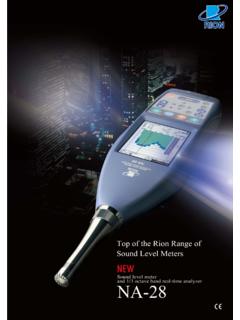Transcription of An Architectural View of LAN Security: In-Band …
1 An Architectural view of LAN security : In-Band versus Out-of- band Solutions Which Approach Offers the Best Performance, security and Manageability? By Nevis Networks Page 1. In-Band versus Out-of- band An Architectural view of LAN security : In-Band versus Out-of- band Solutions Which Approach Offers the Best Performance, security and Manageability? Executive Summary Network Access Control (NAC) and integrated LAN security solutions generally fall into one of two categories, depending on how and where they are deployed in the network. The product can be said to be either an In-Band ( in-line) or out-of- band solution, and the categories are generally mutually exclusive (although there is potential for In-Band appliances to optionally be deployed out-of- band , the converse is not possible).
2 The fundamental differences between the two approaches will have a major impact on the performance, security functionality and manageability of the deployment and should be a prime consideration for enterprises as they consider layering this type of security into their network. The terms In-Band and out-of- band generally refer to whether the solution sits in the flow of all network traffic, or out of the flow, analyzing instead only some of the live data streams. It has always been accepted that being In-Band can offer better security and greater functionality than an out-of- band approach, but could represent a performance bottleneck or a potential point-of- failure in a mission critical network.
3 With the maturity of the Nevis solution, its high-availability and failover features, and its primary design objective for matching and handling peak network performance, the merits of an In-Band solution now greatly outweigh the perceived disadvantages. This paper provides an in-depth comparison of leading edge In-Band and out-of- band approaches, along with the features that customers should ask their potential solution providers for before making their decision. The paper also debunks five common myths often put forth by out-of- band vendors as arguments against In-Band solutions. It starts by describing the two solutions in order to gain a common understanding of what each actually provides.
4 It then goes into the myths, closing with a summary comparison of the two approaches in terms of six common evaluation metrics. Page 2. In-Band versus Out-of- band 1 What Do We Mean By In-Band and Out-Of- band ? LAN security is all about reducing the risks posed by endpoint clients (PCs, laptops, remote systems, and mobile devices) connecting to the internal enterprise network. Risk management and policy enforcement are becoming critical business initiatives as the network perimeter dissolves and as organizations open up their internal LANs to guests, contractors and business partners. Further complicating matters are the emerging need to apply security policies to mobile and remote employees, deal with employee-owned endpoints such as iPhones, and meet compliance requirements for access controls and auditing.
5 LAN security is designed to address these challenges by implementing a broad layer of network security services that protect the network and sensitive resources from untrusted users and systems connecting to the internal enterprise network. The integrated security services required to achieve this level of LAN security can be broadly categorized into pre-connect (prior to connecting to the network) and post-connect features. Pre-connect mechanisms are applied before an endpoint is allowed to join the network and to send and receive traffic. Endpoint compliance posture checking and user authentication are examples of pre-connect mechanisms.
6 Based on the posture status and user identity, a decision can be made as to whether to allow the endpoint to access the network at all, and, if so, what resources it should be allowed to access, and what visibility it should have to the network. A. typical pre-connect posture check would verify that the endpoint system in question is running the latest version of the anti-virus software, and has incorporated required system patches to plug known vulnerabilities. Post-connect mechanisms provide identity-based access controls, traffic monitoring and visualization, and continued assurance that the endpoint should be allowed access based on its acceptable behavior.
7 Certain parts of the network may be off-limits to, if even visible at all by, unauthorized clients. Traffic anomaly detection, intrusion detection using threat signatures, and activity monitoring are examples of post-connect mechanisms. If the client's behavior deviates from the accepted norm, it may raise an alarm, and, depending on the severity, have its access restricted to a quarantine network, or even find itself blocked from further access. Post-connect monitoring would include the ability to detect worm propagation or a bot network that would evade endpoint anti-virus software, and start malicious behavior well after the client logged into the network.
8 The pre-connect phase is inherently driven by compliance checks during the login process and involves at least three network subsystems to determine access policies during this login phase. The first such subsystem, sometimes referred to as the authenticator, interfaces with clients to authenticate users and to gather information about the client's security configuration and other Page 3. In-Band versus Out-of- band health or security posture attributes. The second subsystem is for making policy decisions, and is commonly referred to as a policy decision point, or PDP. The third is for enforcing policy decisions, and is known as a policy enforcement point, or PEP.
9 The following diagram illustrates the flow of traffic between these Architectural components during a typical client login. Considering these mechanisms and Architectural contexts, the differences between the In-Band . and out-of- band approaches to LAN security can be fully contrasted in terms of: Which security services they provide, whether pre-connect, post-connect, or a combination of the two, and How and where they implement the different Architectural components in the network, and its impact on how effectively they can provide these security services. Note: In many cases an agent executing on the endpoint may be used to facilitate things like pre- connect posture checks or user authentication.
10 This discussion is focused on the differences between In-Band and out-of- band approaches, independent of any agent functionality. Agents of any type communicate to the In-Band or out-of- band appliances residing in the network. In-Band Described In-Band appliances sit in the flow of live network traffic, frequently close to where endpoints access the network (potentially in the access layer switch itself), so that all client-side traffic into and out of the network must pass through them. As such, they are able to directly provide both pre-connect and post-connect security services. Most in-line LAN security appliances co-locate the authenticator, PEP, and PDP functions in a single, stand-alone device.





